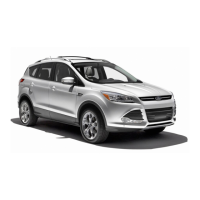The safety belt pretensioners and the
airbag supplemental restraint system is
designed to activate when the vehicle
sustains longitudinal or lateral deceleration
sufficient to cause the restraints control
module to deploy a safety device or when
a certain likelihood of a rollover event is
detected by the rollover sensor.
The fact that the safety belt pretensioners
or airbags did not activate for both front
seat occupants in a collision does not
mean that something is wrong with the
system. Rather, it means the restraints
control module determined the accident
conditions (crash severity, belt usage, etc.)
were not appropriate to activate these
safety devices.
• Front airbags are designed to activate
only in frontal and near-frontal
collisions (not rollovers, side impacts
or rear impacts) unless the collision
causes sufficient longitudinal
deceleration.
• The safety belt pretensioners and rear
inflatable safety belts are designed to
activate in frontal, near-frontal and
side collisions, and in rollovers.
• Side airbags are designed to inflate in
side-impact collisions, not rollovers,
rear impacts, frontal or near-frontal
collisions, unless the collision causes
sufficient lateral deceleration.
• The Safety Canopy is designed to
inflate in certain side impact collisions
or rollover events, not in rear impact,
frontal or near-frontal collisions, unless
the collision causes sufficient lateral
deceleration or rollover likelihood.
AIRBAG DISPOSAL
Contact your authorized dealer as soon as
possible. Airbags MUST BE disposed of by
qualified personnel.
43
Supplementary Restraints System

